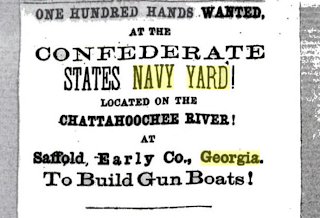When we look at the Civil War era the war overshadows everything else. As a teacher I taught the causes, the battles and the aftermath, but generally due to time constraints I left something important out. I failed to teach about the life that went on during the war. I failed to teach about the folks back home. They still worked, planted their crops, shopped and went to school and church.
Life went on for county governments, too. In fact, two
Georgia counties managed to build courthouses during the war.
Brooks County is one of those counties. It was created in
1858 and named for Preston Brooks who is best known for beating Senator Charles
Sumner unconscious in 1856 due to his anti-slavery stance.
The folks in Brooks County decided to build a courthouse,
and apparently they had the money early on to build a very ornate building. Brooks
County historian Folks Huxford states, “The undertaking to build such a
pretentious and costly edifice in that day and time excited much surprise with
some of the citizens…especially in the adjoining counties most courthouses were
small affairs of rough timber and unpainted.”
County leaders hired John Wind, and English architect who
had been brought to nearby Thomasville by a wealthy planter to design their
courthouse and several large plantation homes including Susana. For his
troubles John Wind was paid one hundred dollars.There were challenges to build something so important during a time of war. There were shortages regarding skilled labor and materials, but later on county leaders were probably glad they proceeded with building a more expensive edifice.
You see, the original building was built entirely with
Confederate dollars - $14,958 to be exact.
Confederate dollars were bills of credit which means they
were backed not by tangible assets such as gold or silver but by a promise to
pay the bearer after the war. Of course, the promise was based on the
Confederate States of America winning the war, and we know how that turned out,
right? I’m fairly certain that Architect
Wind who was paid one hundred dollars for his design, didn’t hold onto his
Confederate pay. He probably spent it the next week as did most of the others
who received pay for the construction of the courthouse, but it is a little
unique fact I find interesting.
Due to shortages certain elements of Wind’s plan were
dropped. Historian Folks Huxford advises, “The parapet, cupola, balustrade on
the roof and certain ornate columns in the courtroom and porticos on the ends
of the building were dispensed with on account of the war.”
Unfortunately, we can’t get a true representation of what
Wind’s finished design looked like because the Brooks County Courthouse underwent
a major renovation in 1892. The picture I post here is the renovated building,
however sources state the original building bore a resemblance to Wind’s other
courthouse design in Thomas County which I’ve posted an image of below.






